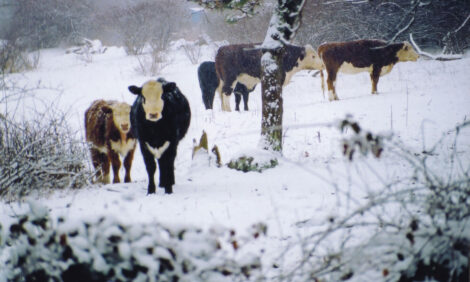



Weekly Roberts Market Report
US - Dairy trade-weighted index is down 14 per cent in the last three sessions and down 23 per cent since the early March peak due to weak global market conditions, writes Michael Roberts.Michael T. Roberts
Extension Agriculture Economist,
Dairy and Commodity Marketing,
NC State University
DAIRY CLASS III futures on the Chicago Mercantile Exchange (CME) closed higher on Monday with
the exception of January 2012 contract which lost $0.05/cwt on the day. The AUG’11DA contract
finished at $21.60/cwt; $0.04/cwt over last Friday’s close and $1.62/cwt higher than last report.
SEP’11DA futures finished at $19.63/cwt; up $0.14/cwt and $0.18/cwt over last report. Despite increasing
cheese prices the market is still considered weak according to several floor sources.
Milk futures were not
as volatile on Monday compared to activity last week. Trading was slow to get started but once going
buying interest was keen.
USDA’s “Milk Production” report is due out Thursday and traders are looking
to see what impact recent heat activity will have on production. The trade-weighted index is down 14 per cent in
the last three sessions and down 23 per cent since the early March peak.
This is a reflection of weaker global
market conditions. The average prices for Class III milk are: three months out = $19.81/cwt ($0.56/cwt lower
than a week ago); six months out = $18.75/cwt ($0.29/cwt under last report); nine months out = $18.14/cwt
($0.20/cwt lower than this time last week); and 12 months out = $17.83/cwt ($0.16/cwt lower than this
time last week).
The long term trend continues to look down as prices are pressured by growing global
supplies and an increase in production from higher cow numbers (See charts below).
LIVE CATTLE futures on the Chicago Mercantile Exchange (CME) finished mixed on Monday with
nearby’s down and deferreds up. AUG’11LC futures closed at $117.900/cwt; even with Friday’s close but
$3.80/cwt higher than a week ago.
The OCT’11LC contract closed at $120.100/cwt; off $0.350/cwt and
but $2.500/cwt over last report. JUNE’12LC futures closed at $124.350/cwt; up $0.025/cwt and
$2.150cwt over last report.
Profit taking from last week’s gains resulted in a market correction. Cash
fundamentals and outside markets were supportive. USDA will release its monthly Cattle on Feed report
on Friday.
Few analysts expect higher-than-July placements that were driven to feedlots by drought since
cattle numbers are tight, rain has started to grow some grass in the West, and cattle were forced into
feedlots earlier than desired.
Placements in Texas, Oklahoma, and New Mexico were 52.5 per cent higher than
the same time last year. Placement estimates from analysts were 115-125 per cent of this time last year. USDA
put the five-area average cash price at $116.13/cwt; $4.92/cwt higher than a week ago. The trend is up (see
chart).
USDA on Monday put the beef cutout at $169.20/cwt; up $2.28/cwt but $5.05/cwt lower than last report.
According to HedgersEdge.com, the average packer margin was lowered $8.75/head to a positive
$24.45/head based on the average buy of $113.89/cwt vs. the average breakeven of $115.78/cwt.
FEEDER CATTLE at the CME closed mixed on Monday. The AUG’11FC contract finished at
$135.650/cwt, down $0.200/cwt but $3.075/cwt higher than last report.
The NOV’11FC contract settled at
$140.000/cwt, up $0.400/cwt and $4.000/cwt over last report.
Feeders followed live cattle higher on the
opening but stayed where most fat cattle futures ran out of steam.
The Oklahoma City Stockyards
estimated receipts at 7,500 head vs. 7,672 last week and 6,221 this time last year. Compared to last week:
seven to eight weight steers were two to three dollars/cwt higher while eight to nine weights sold five to seven dollars/cwt higher.
Heifers were two to five dollars/cwt
higher while steer and heifer calves were three to seven dollars/cwt higher. Demand was good for all classes on improved
quality from last week.
The latest CME feeder cattle index was placed at $134.67; up $0.14 but $0.38
lower than this time last week (See trend chart below).
CORN futures on the Chicago Board of Trade (CBOT) closed up on Monday. SEPT’11 futures closed at
$7.072/bu; up 5.5¢
/bu and 32.0
¢
/bu higher than last Monday.
The DEC’11 contract closed at $7.200/bu;
up 5.5
¢
/bu and 34.0
¢
/bu higher than last report.
A weak US dollar, follow-through from last week, higher
equities (crude and gold), and bullish corn data from USDA last week were supportive. A lower US
dollar makes US origin corn attractive for global importers.
The market continues follow-through
momentum from last week’s larger-than-expected reduction in US production estimates. USDA cut
output forecast 4.1 per cent from July to 12.914 bi bu due to damage from intense heat.
Brazil is looking to
increase corn production as world supply grows tighter and improved technology boost yields. Even
though the US dollar value has declined USDA put corn-inspected-for-export at 27.567 mi bu vs.
expectations for 31-34 mi bu.
International traders told me today they were waiting to see what next week
brings regarding the price of US corn. Late Monday USDA kept the US corn crop in good-to-excellent
condition at 60 per cent; lowering the excellent grade by one per cent and raising the good rating by one per cent.
Chart patterns
indicate price strength weakening. It might be a good idea to price 10 per cent of the 2012 crop.
SOYBEAN futures on the Chicago Board of Trade (CBOT) closed higher on Monday. The SEP’11
contract closed at $13.434/bu; up 15.75
¢
/bu.
NOV’11 soybean futures closed 16.5
¢
/bu higher at
$13.512/bu and 39.75
¢
/bu lower than a week ago.
The MAR’12 contract closed at $13.690/bu; up
16.5
¢
/bu.
Follow-through from last week, dry weather in portions of the US soybean belt, a weaker US
dollar, and spillover from equities and corn were supportive.
Additional and surprising support came from
larger-than-expected US soy crush data for July.
The National Oil Processors Association (NOPA)
placed US July soy crush at 122.952 mi bu; 5.234 mi bu higher than June’s figures and 4.452 over
analysts’ estimates.
Exports were bearish with USDA on Monday putting soybeans-inspected-for-export
at 4.277mi bu vs. estimates for six to 11 mi bu. Soybean prices in Rosario, Argentina closed slightly higher.
WHEAT futures in Chicago (CBOT) closed up on Monday. SEPT’11 futures finished 10.0
¢
/bu higher at
$7.124/bu and 56.0
¢
/bu over last week at this time.
The DEC’11 contract closed at $7.414/bu; up 9.25
¢
/bu
and 46.75
¢
/bu higher than this time last week.
JULY’12 wheat futures finished at $7.912/bu; up 8.0
¢
/bu
and 32.75
¢
/bu higher than last report.
Rising export demand and a lower US dollar were supportive.
USDA put wheat-inspected-for-export at 18.455 mi bu vs. expectations for 22-28 mi bu. Saudi Arabia
was the largest buyer of multi-source wheat on Monday. Easing volatility in some global markets
motivated buyer interest.
Some pit sources said several on the floor are still concerned about supplies
following drought conditions in the US southwest and flooding over late plantings in the northern US
Plains’ states.
Wheat has also been getting a boost from corn as both grains are used for livestock feed.
Look for gains to be limited from increased competition from low-priced- wheat coming from the Black
Sea region. Late Monday USDA put the US spring wheat crop in good-to-excellent condition at 66 per cent,
unchanged from last week.


